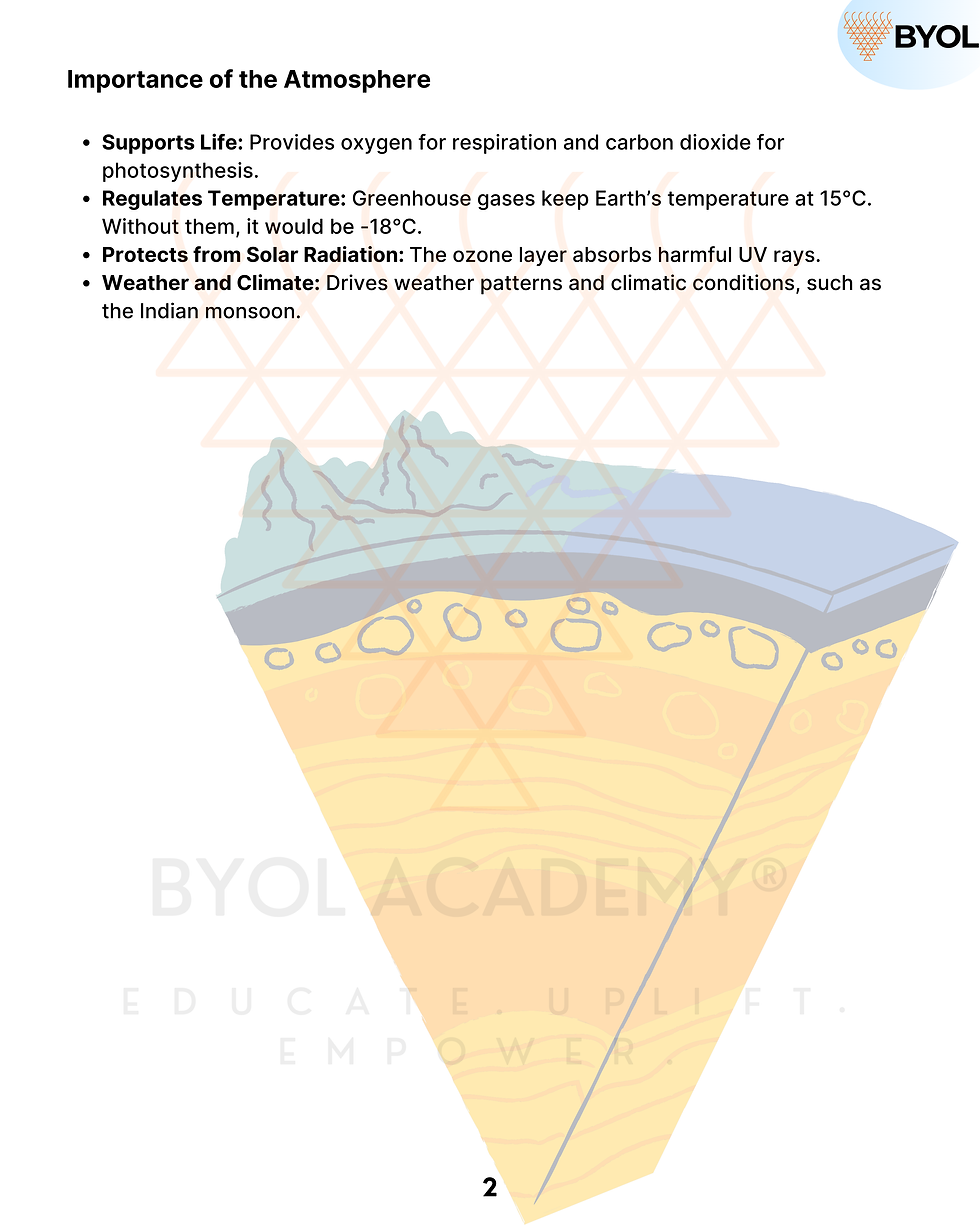Composition and Structure of the Atmosphere
- Pratik Garg

- Mar 21
- 3 min read
Introduction to the Atmosphere
The atmosphere is a layer of gases surrounding the Earth, held in place by gravity.
It is essential for life as it provides oxygen, regulates temperature, and protects against harmful solar radiation.
Example: Without the atmosphere, Earth would be as barren and lifeless as the Moon.
Composition of the Atmosphere
The atmosphere is composed of a mixture of gases, water vapor, and aerosols.
Gases in the Atmosphere
Permanent Gases:
Nitrogen (N₂): 78% of the atmosphere; inert and dilutes oxygen.
Example: Nitrogen is crucial for plant growth as it is a key component of amino acids and proteins.
Oxygen (O₂): 21% of the atmosphere; essential for respiration and combustion.
Example: Oxygen supports aerobic respiration in humans and animals.
Argon (Ar): 0.93%; inert gas.
Carbon Dioxide (CO₂): 0.04%; crucial for photosynthesis and a greenhouse gas.
Example: CO₂ levels have increased due to human activities like burning fossil fuels, contributing to global warming.
Other trace gases: Neon, Helium, Methane, Krypton, Hydrogen, etc.
Variable Gases:
Water Vapor (H₂O): 0-4%; varies with temperature and location.
Example: High water vapor content in tropical regions leads to high humidity and frequent rainfall.
Ozone (O₃): Found in the stratosphere; absorbs harmful ultraviolet (UV) radiation.
Example: The ozone layer over Antarctica has been depleted due to chlorofluorocarbons (CFCs), causing the "ozone hole".
Aerosols: Tiny solid or liquid particles (dust, pollen, smoke, sea salt) that influence climate and weather.
Example: Volcanic eruptions release large amounts of aerosols, which can cool the Earth's surface by reflecting sunlight.
Structure of the Atmosphere
The atmosphere is divided into layers based on temperature variations:
A. Troposphere
Altitude: 0 to 12 km (varies with latitude; 8 km at poles, 18 km at equator).
Characteristics:
Contains 75% of the atmosphere's mass.
Temperature decreases with altitude (6.5°C per km; Environmental Lapse Rate).
Weather phenomena occur here (clouds, rainfall, storms).
Example: Cyclones, thunderstorms, and monsoons occur in the troposphere.
Upper boundary is called the Tropopause.
B. Stratosphere
Altitude: 12 to 50 km.
Characteristics:
Temperature increases with altitude due to ozone absorption of UV radiation.
Example: The ozone layer absorbs UV-B and UV-C rays, protecting life on Earth.
Contains the Ozone Layer (15-35 km).
Calm and stable; ideal for jet aircraft.
Example: Commercial jets fly in the lower stratosphere to avoid turbulence.
Upper boundary is called the Stratopause.
C. Mesosphere
Altitude: 50 to 80 km.
Characteristics:
Temperature decreases with altitude (coldest layer; up to -90°C).
Meteors burn up in this layer.
Example: The "shooting stars" we see are meteors disintegrating in the mesosphere.
Upper boundary is called the Mesopause.
D. Thermosphere
Altitude: 80 to 400 km.
Characteristics:
Temperature increases with altitude (up to 1200°C).
Contains the Ionosphere (80-400 km), which reflects radio waves.
Example: Radio communication over long distances is possible due to the ionosphere.
Aurora phenomena occur here.
Example: The Northern Lights (Aurora Borealis) and Southern Lights (Aurora Australis) occur in the thermosphere.
E. Exosphere
Altitude: 400 km and above.
Characteristics:
Outermost layer; merges with outer space.
Contains light gases like hydrogen and helium.
Example: Satellites orbit the Earth in the exosphere.
Importance of the Atmosphere
Supports Life: Provides oxygen and carbon dioxide for respiration and photosynthesis.
Example: Plants use CO₂ for photosynthesis, and humans rely on oxygen for breathing.
Regulates Temperature: Greenhouse gases maintain Earth's temperature.
Example: Without the greenhouse effect, Earth's average temperature would be -18°C instead of the current 15°C.
Protects from Solar Radiation: Ozone layer absorbs harmful UV rays.
Example: UV radiation can cause skin cancer and cataracts in humans.
Weather and Climate: Drives weather patterns and climatic conditions.
Example: The Indian monsoon is a result of atmospheric circulation patterns.








"This is a really excellent and thorough summary of the Earth's atmosphere. It's clear, concise, and the examples make it easy to understand. Great job!"